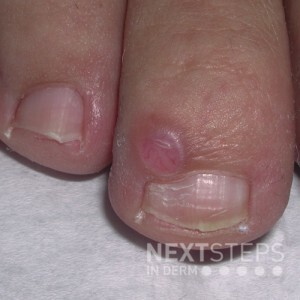OnabotulinumtoxinA for Primary Axillary Hyperhidrosis | Therapeutic Cheat Sheet
 Primary hyperhidrosis (PHH) is a dermatologic condition characterized by overactivity of eccrine glands resulting in excessive sweating primarily affecting the palms, soles, axillae, and craniofacial area. PHH is not caused by other conditions, whereas secondary hyperhidrosis is caused by an underlying medical condition or medication side effect. Botulinum toxin injections are often used as second …
Primary hyperhidrosis (PHH) is a dermatologic condition characterized by overactivity of eccrine glands resulting in excessive sweating primarily affecting the palms, soles, axillae, and craniofacial area. PHH is not caused by other conditions, whereas secondary hyperhidrosis is caused by an underlying medical condition or medication side effect. Botulinum toxin injections are often used as second …
 Primary hyperhidrosis (PHH) is a dermatologic condition characterized by overactivity of eccrine glands resulting in excessive sweating primarily affecting the palms, soles, axillae, and craniofacial area. PHH is not caused by other conditions, whereas secondary hyperhidrosis is caused by an underlying medical condition or medication side effect. Botulinum toxin injections are often used as second …
Primary hyperhidrosis (PHH) is a dermatologic condition characterized by overactivity of eccrine glands resulting in excessive sweating primarily affecting the palms, soles, axillae, and craniofacial area. PHH is not caused by other conditions, whereas secondary hyperhidrosis is caused by an underlying medical condition or medication side effect. Botulinum toxin injections are often used as second … Continue reading "OnabotulinumtoxinA for Primary Axillary Hyperhidrosis | Therapeutic Cheat Sheet"


 What is the eponym for this metastasis to the umbilicus?
A. Tripe palm
B. Sign of Leser-Trelat
C. Pityriasis rotunda
D. Trousseau sign
E. Sister Mary Joseph Nodule
To find out the correct answer and read the explanation, click here.
Brought to you by our brand partner Derm In-Review. A product of SanovaWorks.
…
What is the eponym for this metastasis to the umbilicus?
A. Tripe palm
B. Sign of Leser-Trelat
C. Pityriasis rotunda
D. Trousseau sign
E. Sister Mary Joseph Nodule
To find out the correct answer and read the explanation, click here.
Brought to you by our brand partner Derm In-Review. A product of SanovaWorks.
…  My patient asks about turmeric, neem oil, cardamom, etc. I stubble through what I know. I am a “western-style” physician. I could be cast alongside Eastwood or the Duke (or maybe more accurately Cleavon Little in Blazing Saddles). Anyways, if you are like me and need the crash course, look no further! Before this lecture, I had never heard of Ayurvedic medicine (amazing what we don� …
My patient asks about turmeric, neem oil, cardamom, etc. I stubble through what I know. I am a “western-style” physician. I could be cast alongside Eastwood or the Duke (or maybe more accurately Cleavon Little in Blazing Saddles). Anyways, if you are like me and need the crash course, look no further! Before this lecture, I had never heard of Ayurvedic medicine (amazing what we don� …  During the 2021 ODAC Dermatology, Aesthetic and Surgical Conference, Dr. Jeremy Green, Clinical Assistant Professor of University of Miami Miller School of Medicine and Dermatologist at Skin Associates of South Florida shared PRO TIPS for RF microneedling during his panel presentation “RF technologies, Making sense of it all”
Dr. Green loves RF microneedling for skin tightening/rhytides, …
During the 2021 ODAC Dermatology, Aesthetic and Surgical Conference, Dr. Jeremy Green, Clinical Assistant Professor of University of Miami Miller School of Medicine and Dermatologist at Skin Associates of South Florida shared PRO TIPS for RF microneedling during his panel presentation “RF technologies, Making sense of it all”
Dr. Green loves RF microneedling for skin tightening/rhytides, …  The mucin found in this lesion is produced by:
A. Fibroblasts
B. Keratinocyte
C. Merkel cells
D. Nail matrix
E. Osteoblast
To find out the correct answer and read the explanation, click here.
Brought to you by our brand partner Derm In-Review. A product of SanovaWorks.
…
The mucin found in this lesion is produced by:
A. Fibroblasts
B. Keratinocyte
C. Merkel cells
D. Nail matrix
E. Osteoblast
To find out the correct answer and read the explanation, click here.
Brought to you by our brand partner Derm In-Review. A product of SanovaWorks.
…